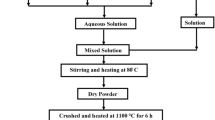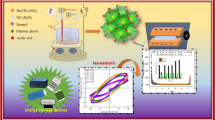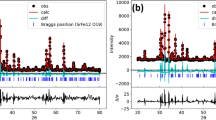Abstract
The electric field–temperature phase diagrams of three bismuth sodium titanate-based relaxor ferroelectrics are reported, namely 0.94(Na1/2Bi1/2TiO3)–0.06(BaTiO3), 0.80(Na1/2Bi1/2TiO3)–0.20(K1/2Bi1/2TiO3) and 0.75(Na1/2Bi1/2TiO3)–0.25(SrTiO3). Relaxor behavior is demonstrated by temperature-dependent dielectric permittivity measurements in the unpoled and poled states, as well as by the field-induced phase transition into a ferroelectric phase from the relaxor phase. From temperature-dependent thermometry measurements, we identified the threshold electric field to induce the ferroelectric phase and obtained the released latent heat of the phase transition. We determined the nonergodic and ergodic relaxor phase temperature range based on the absence or presence of reversibility of the relaxor to ferroelectric transition. For all three compositions, the electric field–temperature phase diagram was constructed and a critical point was identified. The constructed electric field–temperature phase diagrams are useful to find optimum operational ranges of ferroelectrics and relaxors for electromechanical and electrocaloric applications.






Similar content being viewed by others
References
Rödel J, Jo W, Seifert KTP, Anton E-M, Granzow T, Damjanovic D (2009) Perspective on the development of lead-free piezoceramics. J Am Ceram Soc 92(6):1153–1177. https://doi.org/10.1111/j.1551-2916.2009.03061.x
Jo W, Dittmer R, Acosta M, Zang J, Groh C, Sapper E, Wang K, Rödel J (2012) Giant electric-field-induced strains in lead-free ceramics for actuator applications—status and perspective. J Electroceram 29(1):71–93. https://doi.org/10.1007/s10832-012-9742-3
Rödel J, Webber KG, Dittmer R, Jo W, Kimura M, Damjanovic D (2015) Transferring lead-free piezoelectric ceramics into application. J Eur Ceram Soc 35(6):1659–1681. https://doi.org/10.1016/j.jeurceramsoc.2014.12.013
Hussain A, Ahn CW, Lee JS, Ullah A, Kim IW (2010) Large electric-field-induced strain in Zr-modified lead-free Bi0.5(Na0.78K0.22)0.5TiO3 piezoelectric ceramics. Sens Actuators A 158(1):84–89. https://doi.org/10.1016/j.sna.2009.12.027
Ye Z-G, Schmid H (1993) Optical, dielectric and polarization studies of the electric field-induced phase transition in Pb(Mg1/3Nb2/3)O3 [PMN]. Ferroelectrics 145(1):83–108. https://doi.org/10.1080/00150199308222438
Bobnar V, Kutnjak Z, Pirc R, Levstik A (1999) Electric-field–temperature phase diagram of the relaxor ferroelectric lanthanum-modified lead zirconate titanate. Phys Rev B 60(9):6420–6427
Ehara Y, Novak N, Ayrikyan A, Geiger PT, Webber KG (2016) Phase transformation induced by electric field and mechanical stress in Mn-doped (Bi1/2Na1/2)TiO3–(Bi1/2K1/2)TiO3 ceramics. J Appl Phys 120(17):1–7. https://doi.org/10.1063/1.4966614
Jo W, Granzow T, Aulbach E, Rödel J, Damjanovic D (2009) Origin of the large strain response in (K0.5Na0.5)NbO3-modified (Bi0.5Na0.5)TiO3–BaTiO3 lead-free piezoceramics. J Appl Phys 105(9):1–5. https://doi.org/10.1063/1.3121203
Ye Z-G (1996) Relaxor ferroelectric Pb(Mg1/3Nb2/3)O3: properties and present understanding. Ferroelectrics 184(1):193–208. https://doi.org/10.1080/00150199608230260
Novak N, Pirc R, Wencka M, Kutnjak Z (2012) High-resolution calorimetric study of Pb(Mg1/3Nb2/3)O3 single crystal. Phys Rev Lett 109(3):1–5. https://doi.org/10.1103/PhysRevLett.109.037601
Kutnjak Z, Petzelt J, Blinc R (2006) The giant electromechanical response in ferroelectric relaxors as a critical phenomenon. Nature 441(7096):956–959. https://doi.org/10.1038/nature04854
Weyland F, Acosta M, Koruza J, Breckner P, Rödel J, Novak N (2016) Criticality: concept to enhance the piezoelectric and electrocaloric properties of ferroelectrics. Adv Func Mater 26(40):7326–7333. https://doi.org/10.1002/adfm.201602368
Porta M, Lookman T, Saxena A (2010) Effects of criticality and disorder on piezoelectric properties of ferroelectrics. J Phys Condens Matter 22(34):1–14. https://doi.org/10.1088/0953-8984/22/34/345902
Rožič B, Kosec M, Uršič H, Holc J, Malič B, Zhang QM, Blinc R, Pirc R, Kutnjak Z (2011) Influence of the critical point on the electrocaloric response of relaxor ferroelectrics. J Appl Phys 110(6):1–5. https://doi.org/10.1063/1.3641975
Liu Y, Scott JF, Dkhil B (2016) Direct and indirect measurements on electrocaloric effect: recent developments and perspectives. Appl Phys Rev 3(3):1–18. https://doi.org/10.1063/1.4958327
Park S-E, Hong KS (1997) Variations of structure and dielectric properties on substituting A-site cations for Sr2+ in (Na1/2Bi1/2)TiO3. J Mater Res 12(8):2152–2157
Hiruma Y, Imai Y, Watanabe Y, Nagata H, Takenaka T (2008) Large electrostrain near the phase transition temperature of (Bi0.5Na0.5)TiO3–SrTiO3 ferroelectric ceramics. Appl Phys Lett 92(26):1–3. https://doi.org/10.1063/1.2955533
Sapper E, Novak N, Jo W, Granzow T, Rödel J (2014) Electric-field–temperature phase diagram of the ferroelectric relaxor system (1 − x)Bi1/2Na1/2TiO3 − xBaTiO3 doped with manganese. J Appl Phys 115(19):1–7. https://doi.org/10.1063/1.4876746
Ehara Y, Novak N, Yasui S, Itoh M, Webber KG (2015) Electric-field-temperature phase diagram of Mn-doped Bi0.5(Na0.9K0.1)0.5TiO3 ceramics. Appl Phys Lett 107(26):1–5. https://doi.org/10.1063/1.4938759
Acosta M, Jo W, Rödel J (2014) Temperature- and frequency-dependent properties of the 0.75Bi1/2Na1/2TiO3–0.25SrTiO3lead-free incipient piezoceramic. J Am Ceram Soc 97(6):1937–1943. https://doi.org/10.1111/jace.12884
Kutnjak Z, Rožič B, Pirc R (2015) Electrocaloric effect: theory, measurements, and applications. Wiley encyclopedia of electrical and electronics engineering. Wiley, Hoboken
Samara GA, Venturini EL (2006) Ferroelectric/relaxor crossover in compositionally disordered perovskites. Phase Transit 79(1–2):21–40. https://doi.org/10.1080/01411590500418331
Jo W, Schaab S, Sapper E, Schmitt LA, Kleebe H-J, Bell AJ, Rödel J (2011) On the phase identity and its thermal evolution of lead free (Bi1/2Na1/2)TiO3–6 mol% BaTiO3. J Appl Phys 110(7):1–9. https://doi.org/10.1063/1.3645054
Ma C, Tan X (2010) Phase diagram of unpoled lead-free—ceramics. Solid State Commun 150(33–34):1497–1500. https://doi.org/10.1016/j.ssc.2010.06.006
Jo W, Daniels J, Damjanovic D, Kleemann W, Rödel J (2013) Two-stage processes of electrically induced-ferroelectric to relaxor transition in 0.94(Bi1/2Na1/2)TiO3–0.06BaTiO3. Appl Phys Lett 102(19):1–4. https://doi.org/10.1063/1.4805360
Anjali K, Ajithkumar TG, Joy PA (2015) Correlations between structure, microstructure, density and dielectric properties of the lead-free ferroelectrics Bi0.5(Na, K)0.5TiO3. J Adv Dielectr 05(04):1550028. https://doi.org/10.1142/s2010135x15500289
Sasaki A, Chiba T, Mamiya Y, Otsuki E (1999) Dielectric and piezoelectric properties of (Bi0.5Na0.5)TiO3–(Bi0.5K0.5)TiO3 Systems. Jpn J Appl Phys 38:5564–5567
Novak N, Pirc R, Kutnjak Z (2013) Diffuse critical point in PLZT ceramics. EPL 102(1):1–5. https://doi.org/10.1209/0295-5075/102/17003
Sullivan PF, Seidel G (1968) Steady-state, ac-temperature calorimetry. Phys Rev 173(3):679–685
Peräntie J, Hagberg J, Uusimäki A, Jantunen H (2009) Field-induced thermal response and irreversible phase transition enthalpy change in Pb(Mg1/3Nb2/3)O3–PbTiO3. Appl Phys Lett 94(10):1–3. https://doi.org/10.1063/1.3098067
Acknowledgements
This work was financed by the Deutsche Forschungsgemeinschaft (DFG) under the SPP 1599, Project No. 1221/2-1. Malte Vögler acknowledges support under the DFG Grant No. RO954/25.
Author information
Authors and Affiliations
Corresponding author
Ethics declarations
Conflict of interest
There are no conflicts to declare.
Rights and permissions
About this article
Cite this article
Weyland, F., Acosta, M., Vögler, M. et al. Electric field–temperature phase diagram of sodium bismuth titanate-based relaxor ferroelectrics. J Mater Sci 53, 9393–9400 (2018). https://doi.org/10.1007/s10853-018-2232-5
Received:
Accepted:
Published:
Issue Date:
DOI: https://doi.org/10.1007/s10853-018-2232-5




